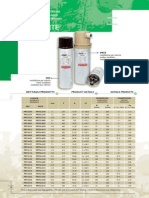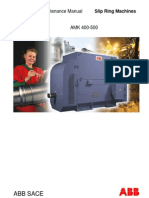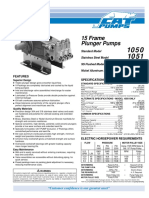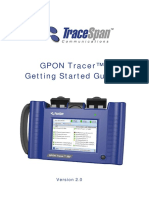Veridri
Veridri
Uploaded by
iviji81Copyright:
Available Formats
Veridri
Veridri
Uploaded by
iviji81Copyright
Available Formats
Share this document
Did you find this document useful?
Is this content inappropriate?
Copyright:
Available Formats
Veridri
Veridri
Uploaded by
iviji81Copyright:
Available Formats
GE
Measurement & Control Solutions Moisture
916-095 Rev. C
March 2011
VeriDri
Moisture Transmitter
Users Manual
www.ge-mcs.com
2011 General Electric Company. All rights reserved.
Technical content subject to change without notice.
GE
Measurement & Control Solutions
VeriDri
Moisture Transmitter
Users Manual
916-095 Rev. C
March 2011
ii
[no content intended for this page]
Preface
VeriDri Users Manual iii
Information Paragraphs
Note paragraphs provide information that provides a deeper understanding of
the situation, but is not essential to the proper completion of the instructions.
Important paragraphs provide information that emphasizes instructions that
are essential to proper setup of the equipment. Failure to follow these
instructions carefully may cause unreliable performance.
Caution! paragraphs provide information that alerts the operator to a hazardous
situation that can cause damage to property or equipment.
Warning! paragraphs provide information that alerts the operator to a
hazardous situation that can cause injury to personnel. Cautionary information
is also included, when applicable.
Safety Issues
WARNING! It is the responsibility of the user to make sure all local, county,
state and national codes, regulations, rules and laws related to
safety and safe operating conditions are met for each
installation.
Auxiliary Equipment
Local Safety Standards
The user must make sure that he operates all auxiliary equipment in accordance
with local codes, standards, regulations, or laws applicable to safety.
Preface
iv VeriDri Users Manual
Working Area
WARNING! Auxiliary equipment may have both manual and automatic
modes of operation. As equipment can move suddenly and
without warning, do not enter the work cell of this equipment
during automatic operation, and do not enter the work
envelope of this equipment during manual operation. If you do,
serious injury can result.
WARNING! Make sure that power to the auxiliary equipment is turned OFF
and locked out before you perform maintenance procedures on
the equipment.
Qualification of Personnel
Make sure that all personnel have manufacturer-approved training applicable to the
auxiliary equipment.
Personal Safety Equipment
Make sure that operators and maintenance personnel have all safety equipment
applicable to the auxiliary equipment. Examples include safety glasses, protective
headgear, safety shoes, etc.
Unauthorized Operation
Make sure that unauthorized personnel cannot gain access to the operation of the
equipment.
Preface
VeriDri Users Manual v
Environmental Compliance
Waste Electrical and Electronic Equipment (WEEE) Directive
GE Measurement & Control Solutions is an active participant in Europes Waste
Electrical and Electronic Equipment (WEEE) take-back initiative, directive
2002/96/EC.
The equipment that you bought has required the extraction and use of natural
resources for its production. It may contain hazardous substances that could impact
health and the environment.
In order to avoid the dissemination of those substances in our environment and to
diminish the pressure on the natural resources, we encourage you to use the
appropriate take-back systems. Those systems will reuse or recycle most of the
materials of your end life equipment in a sound way.
The crossed-out wheeled bin symbol invites you to use those systems.
If you need more information on the collection, reuse and recycling systems, please
contact your local or regional waste administration.
Visit http://www.ge-mcs.com/en/about-us/environmental-health-and-
safety/1741-weee-req.html for take-back instructions and more information
about this initiative.
Preface
vi VeriDri Users Manual
[no content intended for this page]
Contents
VeriDri Users Manual vii
1 Introduction . . . . . . . . . . . . . . . . . . . . . . . . . . . . . . . . . . . . . . . . . . . . . . . . . . . . . . . . . . . . 1
2 Sample System Guidelines . . . . . . . . . . . . . . . . . . . . . . . . . . . . . . . . . . . . . . . . . . . . . . 2
3 Inserting the Transmitter into the Sample System/Process . . . . . . . . . . . . . . . 4
4 Making Wiring Connections . . . . . . . . . . . . . . . . . . . . . . . . . . . . . . . . . . . . . . . . . . . . . 6
5 Operating the Transmitter . . . . . . . . . . . . . . . . . . . . . . . . . . . . . . . . . . . . . . . . . . . . . . 8
5.1 Powering Up. . . . . . . . . . . . . . . . . . . . . . . . . . . . . . . . . . . . . . . . . . . . . . . . . . . . . 8
5.2 Error Handling . . . . . . . . . . . . . . . . . . . . . . . . . . . . . . . . . . . . . . . . . . . . . . . . . . . 8
6 Cleaning the Transmitter Probe . . . . . . . . . . . . . . . . . . . . . . . . . . . . . . . . . . . . . . . . . 9
6.1 Removing the Transmitter . . . . . . . . . . . . . . . . . . . . . . . . . . . . . . . . . . . . . . 10
6.2 Soaking the Sensor and Shield. . . . . . . . . . . . . . . . . . . . . . . . . . . . . . . . . . 11
6.3 Evaluating the Probe . . . . . . . . . . . . . . . . . . . . . . . . . . . . . . . . . . . . . . . . . . . 12
7 Specifications . . . . . . . . . . . . . . . . . . . . . . . . . . . . . . . . . . . . . . . . . . . . . . . . . . . . . . . . 13
7.1 General. . . . . . . . . . . . . . . . . . . . . . . . . . . . . . . . . . . . . . . . . . . . . . . . . . . . . . . . 13
7.2 Electronics. . . . . . . . . . . . . . . . . . . . . . . . . . . . . . . . . . . . . . . . . . . . . . . . . . . . . 14
7.3 Mechanical . . . . . . . . . . . . . . . . . . . . . . . . . . . . . . . . . . . . . . . . . . . . . . . . . . . . 15
7.4 Moisture Sensor. . . . . . . . . . . . . . . . . . . . . . . . . . . . . . . . . . . . . . . . . . . . . . . . 16
Contents
viii VeriDri Users Manual
[no content intended for this page]
Operating Instructions
VeriDri Users Manual 1
1 Introduction
The GE VeriDri
TM
is a low-cost, loop-powered transmitter that provides
accurate dew/frost point measurements covering an overall range of
110
o
to 40C (-166
o
to 104
o
F). It can also be provided to cover a number
of moisture ranges from 0 to 10,000 PPMv.
The VeriDri is supplied with one 4 to 20 mA analog output that is
factory-configured for a specified range.
The VeriDri is easy to install, operate and maintain. This manual contains
the following sections:
Sample System Guidelines
Inserting the Transmitter in the Sample System/Process
Making Wiring Connections
Operating the Transmitter
Cleaning the Transmitter Probe
Specifications
Operating Instructions
2 VeriDri Users Manual
2 Sample System Guidelines
You can install the VeriDri transmitter into a sample system or directly into
the process. GE recommends that the unit be installed in a sample system to
protect the probe from coming into contact with damaging elements in the
process.
Before constructing a sample system, you should consult a GE Applications
Engineer and adhere to the guidelines below. See Figure 1 on page 3 for an
example of a sample system.
Consult Specifications on page 13 for dimensions and other
requirements.
Sample systems should be kept very simple.
The transmitter should be installed so it is perpendicular to the
sample inlet.
The sample system should contain as few components as possible
and all or most of those components should be located downstream
of the measurement location.
If possible, you should use stainless steel material for all wetted
parts.
Sample system components should not be made of any material that
will affect measurement. Most common filters and pressure
regulators are not suitable for sample systems because they have
wetted parts that may absorb or release components (such as
moisture) into the sample system. They may also allow ambient
contamination to enter the sample system.
Operating Instructions
VeriDri Users Manual 3
2 Sample System Guidelines (cont.)
Figure 1: Sample System Example
Sample
Cell
Sample
Inlet
Sample
Outlet
Vent
Operating Instructions
4 VeriDri Users Manual
3 Inserting the Transmitter into the Sample System/Process
CAUTION! If you are mounting the VeriDri directly into the process line,
you must consult the factory for proper installation instructions
and precautions before beginning the following procedure.
Use the steps below to install the VeriDri:
1. Make sure the sintered or sheet stainless-steel shield is in place. The
shield protects the aluminum oxide sensor from damaging elements in
the process.
2. The probe is mounted into the process via the 3/4-16 straight male
thread located on the probe. Thread the probe end of the transmitter into
the process/sample system fitting. Make sure not to cross thread it.
Shield
3/4-16 UNF-2A
Operating Instructions
VeriDri Users Manual 5
3 Inserting the Transmitter into the Sample System/Process
(cont.)
3. Using a 1-1/8 in. wrench, tighten the probe securely into the process
using the probe hex nut.
CAUTION! Do not apply force to the transmitter module to tighten the unit
into its fitting.
Probe Hex Nut
Operating Instructions
6 VeriDri Users Manual
4 Making Wiring Connections
You must wire the transmitter using the factory-supplied cable which is
available in a variety of lengths.
Note: If you need to lengthen cables, refer to Table 1 below to splice an
extension onto the existing cable. Connect positive to positive and
negative to negative.
Use the following steps to wire the transmitter to your system.
1. Push the female connector end on the transmitter cable into the mating
male connector on the transmitter module. Make sure the pins are
properly aligned. Once inserted, secure the connectors together by
sliding the metal sleeve on the cable over the connectors and turning it
clockwise until it is tight.
2. Using the flying leads at the other end of the transmitter cable, connect
the transmitter to your power supply and data acquisition system (DAS)
as shown in Figure 2 on page 7. Refer to Table 1 for a description of the
leads in the factory-supplied cable.
*The blue and brown leads also produce a current output equivalent to
4 to 20 mA.
3. Trim any unused leads back to the outer cable jacket in order to remove
the bare tinned wire and prevent accidental short circuits.
The VeriDri is now ready for operation.
Table 1: Cable Lead Descriptions
Lead Color* Connection Description
Blue (+) 7 to 28 VDC
Brown () 7 to 28 VDC
Connect the shield to ground if desired.
Operating Instructions
VeriDri Users Manual 7
4 Making Wiring Connections (cont.)
Figure 2: Wiring Connections
P
o
w
e
r
a
n
d
M
e
a
s
u
r
e
m
e
n
t
C
i
r
c
u
i
t
s
+7
-
2
8
V
D
C
7
-
2
8
V
D
C
B
l
u
e
B
r
o
w
n
N
o
t
e
:
T
h
e
b
l
u
e
a
n
d
b
r
o
w
n
l
e
a
d
s
a
l
s
o
g
e
n
e
r
a
t
e
a
c
u
r
r
e
n
t
o
u
t
p
u
t
e
q
u
i
v
a
l
e
n
t
t
o
4
t
o
2
0
m
A
.
Operating Instructions
8 VeriDri Users Manual
5 Operating the Transmitter
After proper installation, the VeriDri Transmitter is very easy to use, simply
power the unit up and you are ready to begin taking measurements. Since
the VeriDri stores moisture calibration data in non-volatile FLASH
memory, you do not have to enter data manually or worry about losing data
during a power loss.
Probes may need to be cleaned occasionally depending on the application.
Consult a GE Applications Engineer for required cleaning intervals.
If a problem should arise with the probe, see Error Handling below for how
the transmitter reacts to error conditions.
CAUTION! Any attempt to open the module or remove the sensor probe
will void the warranty.
5.1 Powering Up
After the VeriDri is wired as described in the previous section, you may
apply power to the unit. The transmitter takes approximately 20 seconds to
initialize and begin normal operation. The unit will meet specified accuracy
in 3 minutes.
5.2 Error Handling
In the event of an error condition, the analog output reading is forced to the
following values:
22 mA to indicate a shorted probe
3.5 mA to indicate an open probe
Operating Instructions
VeriDri Users Manual 9
6 Cleaning the Transmitter Probe
CAUTION! Be sure to perform the probe cleaning procedure in a well
ventilated area. Observe all necessary safety precautions when
handling cleaning solvents
To clean the moisture probe, you will need the following:
Three glass (NOT metal) containers containing the following
solvents:
2 containers of approximately 300 ml of reagent-grade hexane or
toluene each.
1 container of approximately 300 ml of distilled (NOT deionized)
water.
IMPORTANT: Make sure the containers are deep enough to submerge the
probe. Do not place the transmitter module into the solvents.
You should only insert the sensor portion of the transmitter
into the solvents.
Rubber or latex gloves.
Oven set at 50C 2C (122F 3.6F) for drying probe.
1-1/8 in. wrench
Use the sections that follow to properly clean the probe.
Operating Instructions
10 VeriDri Users Manual
6.1 Removing the Transmitter
Use the following steps to remove the transmitter from the installation site:
Note: Once the probe is cleaned, it must dry in the oven for 24 hours.
1. Using a 1-1/8 in. wrench, unthread the transmitter from the fitting on
the sample system/process using the probe hex nut as shown below.
2. Record the dew point of the ambient air.
3. Disconnect the cable from the module.
4. Unscrew the stainless-steel shield from the probe mount and carefully
remove it without touching the sensor.
CAUTION! Any attempt to open the module or remove the probe from the
module will void the warranty.
Probe Hex Nut
Shield
Operating Instructions
VeriDri Users Manual 11
6.2 Soaking the Sensor and Shield
CAUTION! Do not place the transmitter module into the solvents. You
should only insert the sensor portion of the transmitter into the
solvents. Also, do not allow the sensor to come into contact with
the surfaces of the cleaning containers or any other hard
surface.
1. Wearing gloves, place the sensor in the first container of hexane or
toluene and allow it to soak for 10 minutes.
2. Remove the sensor from the hexane or toluene and soak it in the
container of distilled water for 10 minutes.
3. Remove the sensor from the distilled water and soak it in the second
(clean) container of hexane or toluene for 10 minutes.
4. Remove the sensor from the hexane or toluene and set it aside until the
shield has completed the cleaning cycle.
5. Repeat steps 1 to 3, above, to clean the shield. To ensure the removal of
any contaminants that may have become embedded in the porous walls
of the shield, swirl the shield in the solvents during the soaking
procedure.
6. Remove the shield from the hexane or toluene.
7. Carefully replace the shield over the exposed sensor without touching
it.
8. Place the sensor with the shield in an oven set at 50C 2C
(122F 3.6F) for 24 hours.
Operating Instructions
12 VeriDri Users Manual
6.3 Evaluating the Probe
1. Re-connect the cable to the transmitter module and measure the dew
point. Make sure you measure the same ambient air as measured in
step 2 on page 10.
2. Compare the two ambient air readings. If the new ambient air reading is
within 2C (3.6F) of the first reading, the cleaned probe is properly
calibrated and may be reinstalled. If it is not, proceed to step 3 below.
3. If the probe is still not reading the ambient air accurately, repeat the
cleaning procedure using soaking times that are 5 times the previous
cleaning sequence, until two consecutive ambient air readings are
identical.
If the above cleaning procedure does not result in accurate readings, contact
the factory for assistance.
Operating Instructions
VeriDri Users Manual 13
7 Specifications
7.1 General
Moisture Ranges
110
o
to 20C
110
o
to 50C
80
o
to 20C
80
o
to 30C
30
o
to 20C
60
o
to 40C
150
o
to 70F
150
o
to 40F
40
o
to 70F
100
o
to 0F
50
o
to 50F
0
o
to 100F
0 to 10 PPMv
0 to 100 PPMv
0 to 1000 PPMv
0 to 10,000 PPMv
Note: PPMv ranges based on constant pressure, provided at time of order
placement.
Operating Temperature
40 to 60C (40 to 140F)
Storage Temperature
70C (158
o
F) maximum. The probe should be stored with the plastic cover
and desiccant packet threaded onto the probe. Store in a cool, dry
environment.
Operating Instructions
14 VeriDri Users Manual
7.1 General (cont)
Warm-up Time
Meets specified accuracy in 3 minutes
Calibrated Accuracy at 25C (77F)
2C (3.6F) from 65
o
to 10C (85
o
to 50
o
F)
3C (5.4F) from 80
o
to 66C (112
o
to 87
o
F)
Repeatability
0.5C (0.9F) from 65
o
to 10C (85
o
to 50
o
F)
1.0C (1.8F) from 80
o
to 66C (112
o
to 87
o
F)
7.2 Electronics
Power
Supply voltage:
7 to 28 VDC (loop-powered, customer supplied)
Output:
4 to 20 mA
Output Resolution:
0.01 mA
Max. Loop R = 50 (PSV7),
where PSV = Power Supply Voltage
Example:
Given a 24 VDC Power Supply,
Max. Loop R = 50 (247)
= 850
Cable:
2 m, standard (consult factory for custom lengths)
Operating Instructions
VeriDri Users Manual 15
7.3 Mechanical
Sample Connection
3/4-16 straight male thread with o-ring
Operating Pressure
5 m Hg to 5,000 psig (345 bar)
Enclosure
NEMA 4X/IP67
European Compliance
Complies with the following:
EMC Directive 2004/108/EC and PED 97/23/EC for DN<25
EN 61326:1998; Class A, Annex A, Continuous Unmonitored
Operation (For EN 61000-4-3 transmitter meets performance criteria
A and in a number of frequencies, criteria B per EN 61326)
Dimensions
Overall: 6.76 1.13 in. (17.17 2.87 cm)
Electronics with cable: 4.08 1.13 in. diameter
(10.36 2.87 cm)
Weight: 5 oz (140 grams)
Operating Instructions
16 VeriDri Users Manual
7.4 Moisture Sensor
Sensor Type
Thin-film aluminum oxide moisture sensor probe
Calibration
Each sensor is individually computer-calibrated against known moisture
concentrations, traceable to NIST
Calibration Interval
Sensor recalibration at GE Infrastructure Sensing is recommended every six
to 12 months depending on application
Calibration Data
Factory-calibrated, stored in FLASH
Flow Rate
Gases: Static to 10,000-cm/s linear velocity at a pressure of 1 atm
Liquids: Static to 10-cm/s linear velocity at density of 1 g/cc
Warranty
VeriDri Users Manual 17
Warranty
Each instrument manufactured by GE Sensing is warranted to be free from defects
in material and workmanship. Liability under this warranty is limited to restoring
the instrument to normal operation or replacing the instrument, at the sole
discretion of GE Sensing. Fuses and batteries are specifically excluded from any
liability. This warranty is effective from the date of delivery to the original
purchaser. If GE Sensing determines that the equipment was defective, the warranty
period is:
one year from delivery for electronic or mechanical failures
one year from delivery for sensor shelf life
If GE Sensing determines that the equipment was damaged by misuse, improper
installation, the use of unauthorized replacement parts, or operating conditions
outside the guidelines specified by GE Sensing, the repairs are not covered under
this warranty.
The warranties set forth herein are exclusive and are in lieu of all
other warranties whether statutory, express or implied (including
warranties or merchantability and fitness for a particular purpose,
and warranties arising from course of dealing or usage or trade).
Warranty
18 VeriDri Users Manual
Return Policy
If a GE Sensing instrument malfunctions within the warranty period, the following
procedure must be completed:
1. Notify GE Sensing, giving full details of the problem, and provide the model
number and serial number of the instrument. If the nature of the problem
indicates the need for factory service, GE Sensing will issue a RETURN
AUTHORIZATION NUMBER (RAN), and shipping instructions for the
return of the instrument to a service center will be provided.
2. If GE Sensing instructs you to send your instrument to a service center, it must
be shipped prepaid to the authorized repair station indicated in the shipping
instructions.
3. Upon receipt, GE Sensing will evaluate the instrument to determine the cause
of the malfunction.
Then, one of the following courses of action will then be taken:
If the damage is covered under the terms of the warranty, the instrument will be
repaired at no cost to the owner and returned.
If GE Sensing determines that the damage is not covered under the terms of the
warranty, or if the warranty has expired, an estimate for the cost of the repairs at
standard rates will be provided. Upon receipt of the owners approval to
proceed, the instrument will be repaired and returned.
GE
Sensing
DECLARATION
OF
CONFORMITY
DOC-0025, Rev. A
We, GE Sensing
1100 Technology Park Drive
Billerica, MA 01821
USA
declare under our sole responsibility that the
VeriDri Moisture Transmitter
to which this declaration relates, is in conformity with the following standards:
EN 61326-1: 2006, Class A, Table 2, Industrial Locations
EN 61326-2-3: 2006
EN 60529: 2001, IP67
following the provisions of the 2004/108/EC EMC Directive.
The unit listed above and any ancillary equipment supplied with it do not bear CE marking
for the Pressure Equipment Directive, as they are supplied in accordance with Article 3,
Section 3 (sound engineering practices and codes of good workmanship) of the Pressure
Equipment Directive 97/23/EC for DN<25.
Billerica - August 2010
Issued
Mr. Gary Kozinski
Certification & Standards, Lead Engineer
An ISO 9001:2008 Certified Company
www.ge-mcs.com/en/about-us/quality.html
www.ge-mcs.com
2011 General Electric Company. All rights reserved.
Technical content subject to change without notice.
916-095 Rev. C
Customer Support Centers
U.S.A.
The Boston Center
1100 Technology Park Drive
Billerica, MA 01821
U.S.A.
Tel: 800 833 9438 (toll-free)
978 437 1000
E-mail: sensing@ge.com
Ireland
Sensing House
Shannon Free Zone East
Shannon, County Clare
Ireland
Tel: +35 361 470291
E-mail: gesensingsnnservices@ge.com
You might also like
- Electrical Instrument Interface PhilosophyNo ratings yetElectrical Instrument Interface Philosophy11 pages
- Elite 440 Technical Reference Manual BGX501-728-R0460% (5)Elite 440 Technical Reference Manual BGX501-728-R0480 pages
- Functional Safety Switch Amplifier KFD2-SR2-Ex .W (.LB) : ManualNo ratings yetFunctional Safety Switch Amplifier KFD2-SR2-Ex .W (.LB) : Manual24 pages
- Rodent System-Do's & Don't For Maser V2 ModelsNo ratings yetRodent System-Do's & Don't For Maser V2 Models1 page
- 3500/42M Proximitor Seismic Monitor: DatasheetNo ratings yet3500/42M Proximitor Seismic Monitor: Datasheet18 pages
- Post Graduate Diploma in Industrial Automation (PGDIA) NewNo ratings yetPost Graduate Diploma in Industrial Automation (PGDIA) New4 pages
- Test Certificate For Multi-Turn Actuators: Setting and Functional TestNo ratings yetTest Certificate For Multi-Turn Actuators: Setting and Functional Test1 page
- Avinash: Akshar Precision Tubes Pvt. LTDNo ratings yetAvinash: Akshar Precision Tubes Pvt. LTD1 page
- 2-Wire, RH+T Transmitters: 2 X 4 20 Ma Outputs Ip65/Ip66 Dual LCD Display Flameproof SC805, SC806, SC807No ratings yet2-Wire, RH+T Transmitters: 2 X 4 20 Ma Outputs Ip65/Ip66 Dual LCD Display Flameproof SC805, SC806, SC8076 pages
- 5040 - MASIBUS CONTROLLER User - Manual PDFNo ratings yet5040 - MASIBUS CONTROLLER User - Manual PDF53 pages
- 7812 Gas Density Meter Installation Configuration Manual en 63108 PDFNo ratings yet7812 Gas Density Meter Installation Configuration Manual en 63108 PDF98 pages
- User Manual-Industry Robot Control System - LT PDFNo ratings yetUser Manual-Industry Robot Control System - LT PDF113 pages
- A1SJ71 (U) C24-R4 - User - S Manual (Hardware) IB (NA) - 66491-D (02.09)No ratings yetA1SJ71 (U) C24-R4 - User - S Manual (Hardware) IB (NA) - 66491-D (02.09)24 pages
- Programmable Signal Isolator: Universal Input, 5 Outputs, Integral LCD DisplayNo ratings yetProgrammable Signal Isolator: Universal Input, 5 Outputs, Integral LCD Display7 pages
- Monthly Report in September: Engineering DepartmentNo ratings yetMonthly Report in September: Engineering Department11 pages
- 2016 Industrial Controls Catalog Nov 2015 PDFNo ratings yet2016 Industrial Controls Catalog Nov 2015 PDF1,568 pages
- Item 13 SW Cooling Pump Misc Equip Sys - 721-113.10No ratings yetItem 13 SW Cooling Pump Misc Equip Sys - 721-113.10430 pages
- Dokumen - Tips Krohne Ifc 021 K F Signal Converter Catalogue As Per New L Easy User FriendlyNo ratings yetDokumen - Tips Krohne Ifc 021 K F Signal Converter Catalogue As Per New L Easy User Friendly8 pages
- MatrikonOPC UA Wrapper For COM OPC Servers User ManualNo ratings yetMatrikonOPC UA Wrapper For COM OPC Servers User Manual45 pages
- 0299 - 1.5 SQMM X 2 Cop Armd Stand FRLS RedNo ratings yet0299 - 1.5 SQMM X 2 Cop Armd Stand FRLS Red1 page
- DP Transmitter Yokogawa EJX 110A Fieldbus System100% (1)DP Transmitter Yokogawa EJX 110A Fieldbus System162 pages
- Emergi-Lite Emergency Lighting CatalogueNo ratings yetEmergi-Lite Emergency Lighting Catalogue105 pages
- Product Details - Industry Mall - Siemens WWNo ratings yetProduct Details - Industry Mall - Siemens WW2 pages
- rls3d d10 Plus Robot Vacuum and Mop ManualNo ratings yetrls3d d10 Plus Robot Vacuum and Mop Manual28 pages
- Dme 58828 956a7630g02 Leap 00 GH 02 01 02a 066a C - 002 00 - en UsNo ratings yetDme 58828 956a7630g02 Leap 00 GH 02 01 02a 066a C - 002 00 - en Us21 pages
- UM33A Digital Indicator With Alarms Operation Guide - IM05P03D21-11EN - 020No ratings yetUM33A Digital Indicator With Alarms Operation Guide - IM05P03D21-11EN - 0208 pages
- ET32413 Series Benchtop Digital Multimeter User Manual V0No ratings yetET32413 Series Benchtop Digital Multimeter User Manual V042 pages
- UD15088B - Baseline - User Manual of Turbo HD Digital Video Recorder - V4.21.000 - 20190613No ratings yetUD15088B - Baseline - User Manual of Turbo HD Digital Video Recorder - V4.21.000 - 20190613220 pages
- DPU40D-N06A3, OPM40M Ver.B, OPM30M Ver.D, OPM30M Ver.E Regulatory Compliance StatementNo ratings yetDPU40D-N06A3, OPM40M Ver.B, OPM30M Ver.D, OPM30M Ver.E Regulatory Compliance Statement8 pages
- Intel Realsense Lidar Camera L515: DatasheetNo ratings yetIntel Realsense Lidar Camera L515: Datasheet25 pages
- GB Electric Built in Ceramic Hob: Elektrisk Inbyggbar Kokhäll Sisäänrakennettu LiesitasoNo ratings yetGB Electric Built in Ceramic Hob: Elektrisk Inbyggbar Kokhäll Sisäänrakennettu Liesitaso12 pages
- SilverCrest 10in1 Remote Control ManualNo ratings yetSilverCrest 10in1 Remote Control Manual72 pages
- MOTOTRBO R2 Portable Radio Basic Service ManualNo ratings yetMOTOTRBO R2 Portable Radio Basic Service Manual951 pages


































































































